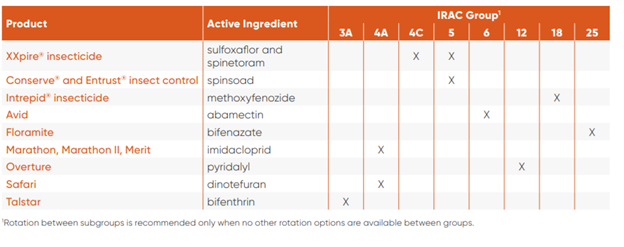Understanding insecticide resistance

When you find something that works, the instinct is to stick with it. However, when it comes to pesticides, overuse of favorite products leads to the development of insecticide resistance.
Resistance is a change in the susceptibility of some insects or mites in an arthropod pest population to an insecticide. This change allows them to survive insecticide applications that previously controlled them and subsequently pass the resistance traits to the next generation.
To reduce the risk of resistance, it is important to rotate pesticides – not by brand or trade name, but by active ingredients and modes of action.
The Insecticide Resistance Action Committee (IRAC) groups pesticides by mode of action (MOA). Different chemical classes can have similar modes of action and are listed as subgroups. Rotating insecticides based on MOA reduces the chance of resistance developing. The modes of action of insecticides and miticides are numbered, color coded and available on the IRAC website. In addition, the IRAC group number or numbers are listed on the product label of every insecticide. The chart below details commonly used insecticides, their active ingredients and their respective IRAC groups.

To minimize the risk of pest populations developing resistance, follow these guidelines:
Strictly adhering to insecticide resistance management practices can help reduce the chance of resistance developing in the first place.
XXpire is not registered for sale or use in all states. Contact your state pesticide regulatory agency to determine if a product is registered for sale or use in your state. State restrictions on the sale and use of Entrust and Intrepid apply. Consult the label before purchase or use for full details. Always read and follow label directions.
When it comes to the challenges you face, you’re the expert. We’re here to help you tackle those challenges and bolster your business.
Effective weed control starts with identification. Learn to identify 90+ grassy and broadleaf weeds.